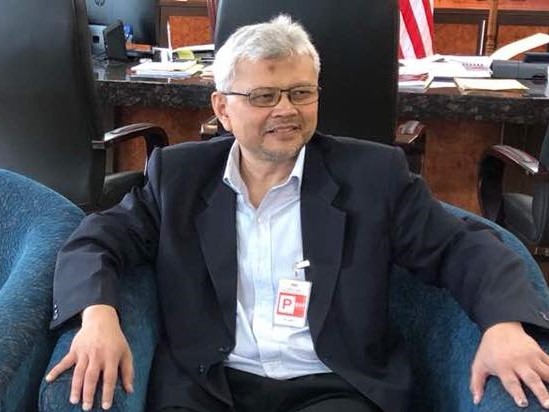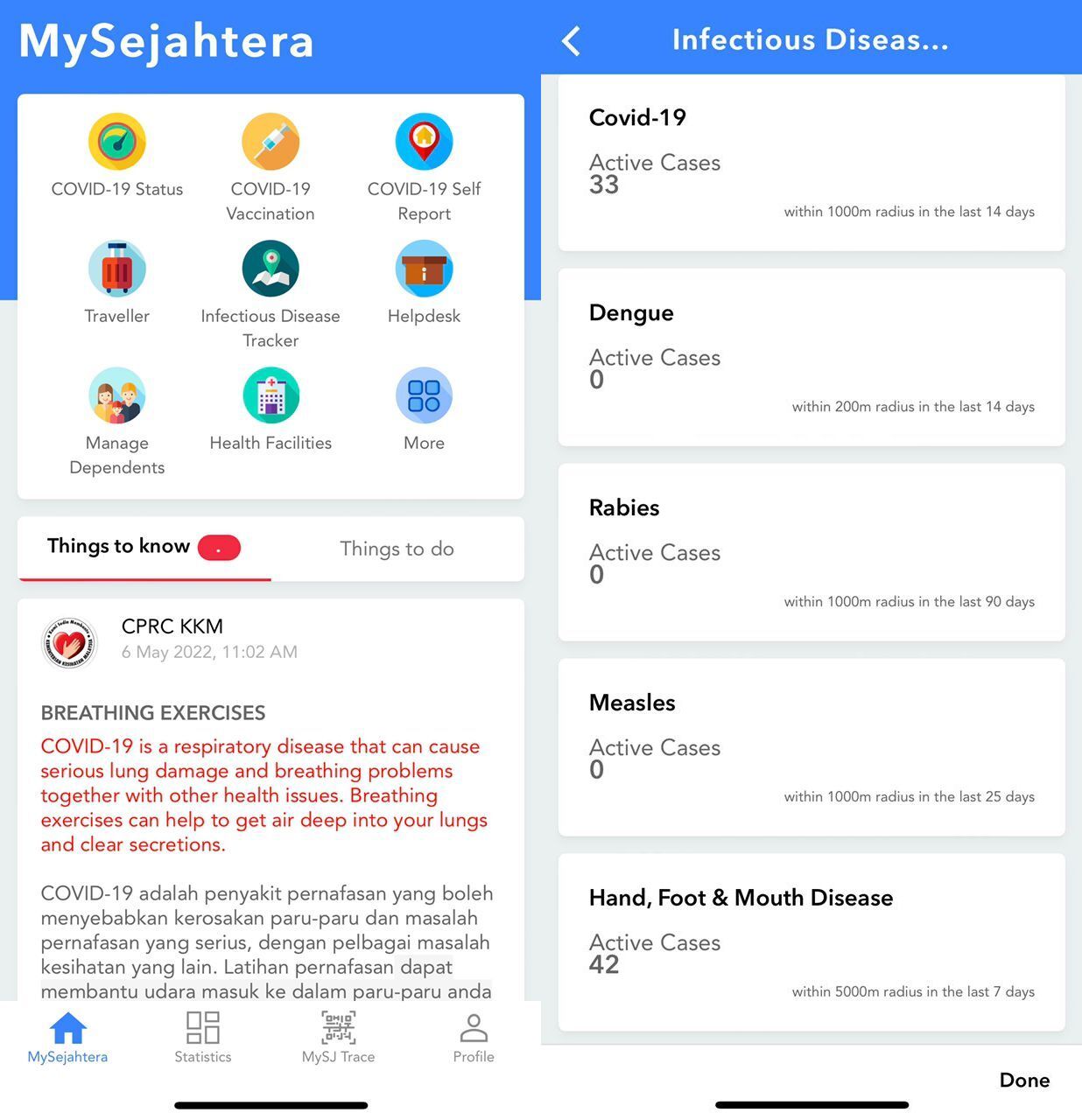KUALA LUMPUR, May 16 – Public health experts say it is not useful for the new MySejahtera infectious disease tracker to simply state the number of cases in one’s vicinity, without guidance on follow-up action or what the figures mean.
The new MySejahtera feature – which was launched after check-in mandates on the Covid-19 app were dropped May 1 – lists the number of active cases of Covid-19, dengue, rabies, measles, hand, foot and mouth disease (HFMD), and tuberculosis within a certain radius of up to 5km and a certain time period of up to the last 90 days.
However, the app’s tracker does not state the symptoms of the respective disease, methods of transmission, which groups of people are at highest risk, how to prevent infection, what to do if any number of cases are reported in one’s vicinity, or what case number is considered by the Ministry of Health (MOH) to be a “hotspot” or to exceed normal levels in certain locations of these endemic diseases.
Although there were May 7 and May 8 posts on the MySejahtera app’s homepage about HFMD, these posts have been superseded by other announcements and have since completely disappeared from the homepage. On the infectious disease tracker itself, tapping on the relevant disease does not yield pop-ups of information about the condition.
Dr Lokman Hakim Sulaiman, who is pro vice chancellor of research and professor of public health at International Medical University, said he was unsure about the purpose of the MySejahtera tracker, questioning why a certain time period was selected for each communicable disease — last seven days for HFMD, 14 days for Covid-19 and dengue, 25 days for measles, 60 days for tuberculosis, and 90 days for rabies.
“Is it incubation period? Maybe yes for rabies, but certainly not for measles! Fourteen days of dengue outbreak?” Dr Lokman told CodeBlue.
Measles is one of the world’s most contagious diseases, where infected people can spread measles to others from four days before through four days after the rash appears. Almost all dengue transmission occurs through the bite of infected Aedes mosquitoes.
“I guess the purpose is just to alert public about the occurrence of the infection nearby, but does that necessarily mean higher risk? Not really.”
“HFMD for example — is it helpful for parents to decide sending their child to nursery or not just by numbers? I don’t think so, unless they know their nursery is affected.”
Dr Lokman Hakim Sulaiman, pro vice chancellor of research at International Medical University
The researcher in epidemiology and infectious disease said epidemiologists understand the importance and value of case numbers because they have other information like geolocation data and date of onset of symptoms, among other details, “but for the general public?”
“During my time, we shared information on dengue hotspots, not just the [case] numbers, so that the community takes ownership and participates in community actions to control it,” said Dr Lokman, a former Health deputy director-general (public health), who served from 2011 to 2017.
Understanding How Diseases Are Transmitted More Important Than Case Numbers

Dr Helmi Zakariah – who created the Selangor state government’s Covid-19 app, SELangkah – said the MySejahtera infectious disease tracker should be improvised to create context for users on the reported active case numbers.
“As with Covid previously, a single absolute number (round number?) is hard to be utilised. Best if it’s combined with some context, like ‘baseline numbers’, especially so because many of the diseases listed are already endemic (with the exception of Covid),” Dr Helmi told CodeBlue.
“Thus, with any endemic disease, some inherent numbers are acceptable. Local trends will be useful as a comparison. Not all numbers besides 0 should be taken as an alarming sign.”
He also said that although the exact GPS points of reported cases of Covid-19, dengue, rabies, measles, and HFMD are hidden from the MySejahtera app’s user interface, ambiguity could cause speculations that could be just as damaging.
“Historically, a case of rabies can lead to public overreaction, which leads to local authority over-reaction too, especially when the ethical treatment of strays in Malaysia still has a lot left to be desired.”
Dr Helmi Zakariah, Selangkah Ventures Sdn Bhd chief information officer
The public health expert stressed that data must be accompanied by health education, pointing out that when he previously served as a medical officer in Klang, it was common to see working parents dropping off sick children in daycare centres because childcare was difficult.
“Public understanding of ‘method of transmission’ is more important than simply knowing numbers alone,” Dr Helmi said.
“For example, if you’re a parent with kids in daycare, knowing HFMD and its means of transmission is important for parents to break the chain of infection (and also to nudge them to care for their children at home and resist dropping a sick child at daycare).”
HFMD is a common and usually mild infection in children that causes ulcers in the mouth and a rash or blisters on hands, feet, legs, or buttocks. The infectious disease spreads through coughing or sneezing, sharing utensils, contact with faeces like when changing a diaper, and touching surfaces with the viruses that cause HFMD on them.
MySejahtera Tracker Lacks Recommended Follow-Up Action

Consultant paediatrician Dr Musa Mohd Nordin pointed out that outbreaks like HFMD or measles are usually associated with targeted communities, such as nurseries, rumah panjang, tahfiz schools etc.
“Just providing information on an HFMD outbreak in a 1km or 5km radius is not beneficial to the lay public, as this information, once gotten, does not have any continuity of follow-on action,” Dr Musa told CodeBlue.
“For example, you see an HFMD outbreak within a 5km radius from you. What do you do? Keep your kids at home? Don’t send them to school etc? There is no continuity of information transfer.”
“Data must come along with health education in tandem. Public understanding of the ‘method of transmission’ is more important than simply knowing numbers alone.”
Dr Musa Mohd Nordin, consultant paediatrician
He said the MySejahtera infectious disease tracker “serves no useful purpose” if there are no recommended preventive measures for prompt and appropriate responses from the individual and community.
“People are only useful when they know what to do with the information given. Otherwise, it just creates confusion and maybe even a panic situation.”
Dr Musa stressed that a “numbers game devoid of context” bordered on fear mongering and punitive measures.
“No room should be left to ambiguity because it only leads to speculation, which is counter-productive and maybe even dangerous. Public overreaction to a case of rabies in the neighbourhood may lead to vigilante-like responses which are neither ethical nor problem solving. Data protection to avoid stigma is extremely crucial.”
The health expert also pointed out that the 96 per cent decline in people checking in on MySejahtera means that the majority do not open the mobile app anymore. According to data from MOH’s GitHub, the number of unique individuals checking in on MySejahtera fell from a high of 11.6 million last November 3 to about 442,000 on May 14 this year.
Dr Musa suggested push notifications on important infectious disease outbreaks, like rabies, where MySejahtera app users will receive push notifications upon entering a geo-fenced area, supplemented with information like to avoid approaching or feeding stray dogs or to go directly to the hospital if bitten.
“Or in the case of leptospirosis outbreak, once one enters BT 20 Hulu Langat, one receives a push notification on the current outbreak – with continuity and seamless flow of actionable information – such as, do not swim in rivers/ lakes, if you do and have these symptoms, report on the app and go to the nearest health care facility etc.
“Empowering the public with health information that is directly relevant to their circumstances helps to modify behaviours and be an active partner towards putting a stop to an outbreak.”
Design App Based On User Feedback

Consultant obstetrics and gynaecologist Dr Milton Lum suggested that MOH conduct a small random poll to ask people what they want from MySejahtera and what they would find helpful, before designing changes or introducing new functions on the app.
“This was obviously done without feedback from the user. End user feedback is very important,” Dr Lum told CodeBlue.
He also said notifying cases of infectious disease within a radius as large as up to 5km was of no use to Malaysians and that it should be narrowed to within 100 to 200 metres.
The MySejahtera tracker uses a radius of 5km for HFMD, 1km for rabies, measles, tuberculosis, and Covid-19, and 200 metres for dengue.
Dr Lum criticised the lack of health information or advice for MySejahtera users on the various communicable diseases tracked by the app, pointing out that MOH’s National Health and Morbidity Survey 2019 found low health literacy among one-third of Malaysian adults.
“Putting a number doesn’t mean anything. You also have got to issue guidelines on what to do.”
Dr Milton Lum, former president of the Malaysian Medical Association
The former Malaysian Medical Association president also said the MySejahtera infectious disease tracker should provide the reporting trend of the illnesses tracked for users to see if cases are increasing or dropping, the type of locations where cases are reported (such as whether HFMD cases were reported in schools or daycare centres), and symptoms, as many people do not know what is HFMD, for example.
“Whatever you do, you have to answer — what is your objective?” Dr Lum told MOH. “Is it user-friendly? Would it stimulate the user to take action, and what kind of action to take? If you just put the number there, so what?”








